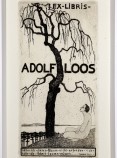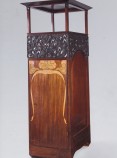Otto Wagner and the Secession

Chair. 1906. Josef Hoffmann. Hummel Collection, Vienna. Photo: Gisela Erlacher

Exlibris. 1925. L. Steiner / Adolf Loos. Hummel Collection, Vienna. Photo: Gisela Erlacher

Chest. About 1900. J. Olbrich. Hummel Collection, Vienna. Photo: Gisela Erlacher
Otto Wagner began the transition from historicism to modernity in Vienna. He defended the great modern metropolis and the adaptation of its architecture and urban planning to the modern man, dedicated to the economy. He held that form responds to function and that practical objects should be created on the basis of modern technologies and new construction materials. On the other hand, the artists of the Secession found refuge in ornamentation grounded in abstract motifs inspired in nature, seeking to transform life into art. Home furniture and accessories were required to respond to the psyche of the new man. Adolf Loos would boldly respond to this state of the question with his radical stance against ornamentation.
“Something impractical cannot be beautiful.”
Otto Wagner



